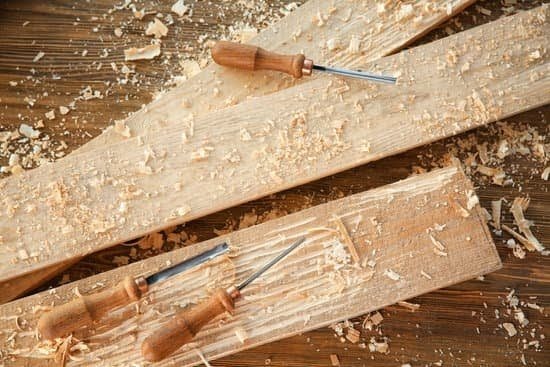When it comes to woodworking, there is an endless array of projects that can be tackled. From crafting intricate furniture pieces to building impressive structures, woodwork offers a world of possibilities. One area of woodworking that requires special attention and precision is angled woodwork. Whether it’s creating beveled edges, chamfering corners, or shaping intricate designs, working with angles adds complexity and challenge to any project.
To achieve optimal results in angled woodwork, it is crucial to use the right tools. And one tool that plays a significant role in this type of woodworking is a sander. A sander not only smooths out rough surfaces but also helps shape and refine angled woodwork. However, not all sanders are created equal, and using the wrong type for angled projects can lead to uneven surfaces and imprecise finishes.
Understanding the specific requirements of working with angles is essential when choosing the right sander for your projects. In this article, we will explore the world of angled woodwork and delve into the importance of using a sander specifically designed for this purpose. We will discuss various types of sanders available in the market, their features and applications, and highlight must-have features in a sander for angled woodwork.
By gaining a comprehensive understanding of what kind of sander works best for angled woodwork, you’ll be well-equipped to handle even the most challenging projects with ease and precision. So let’s dive into this fascinating world where angles meet craftsmanship.
Understanding the Different Types of Sanders
When it comes to woodworking, having the right tools is essential for achieving professional-looking results. This is especially true when working with angled surfaces, where precision and accuracy are key. To ensure that you get the best finish on your angled woodwork, it is important to understand the different types of sanders available in the market.
Belt Sanders
Belt sanders are a popular choice for working with angled wood surfaces due to their powerful motor and aggressive sanding action. These sanders feature a continuous loop of sandpaper wrapped around two drums that rotate rapidly, providing a consistent, smooth finish on various angles and contours. The wide belt allows for excellent material removal, making it ideal for shaping or leveling uneven surfaces.
One of the main advantages of using a belt sander for angled woodwork is its ability to quickly remove material and smooth out imperfections. This makes them particularly useful for projects such as refinishing furniture or preparing rough lumber. Additionally, belt sanders often come with adjustable angle features that allow you to easily tackle beveled edges or curved surfaces.
Orbital Sanders
While belt sanders excel at heavy-duty tasks, orbital sanders offer a more delicate touch when working on angled wood surfaces. Orbital sanders utilize a circular motion combined with random orbital patterns to minimize swirls or scratches on the material. These sanders are known for their versatility and ability to provide a fine finish without compromising speed or efficiency.
When choosing an orbital sander for angled woodwork, consider models with smaller pad sizes as they offer better maneuverability and access to tight corners or intricate details. Additionally, look for orbital sanders with variable speed settings so that you can adjust the aggressiveness of the machine based on your specific project needs.
Ultimately, both belt sanders and orbital sanders have their merits in handling angled woodwork. While belt sanders are perfect for heavy-duty tasks and material removal, orbital sanders excel at providing a smooth and fine finish. Depending on the nature of your project, you may choose to use one or both types of sanders in combination to achieve the desired result.
By understanding the different types of sanders available and their specific features, you can make an informed decision when selecting a sander for your angled woodwork projects. Keep in mind that it is crucial to choose a sander that suits the needs of your specific project, whether it be aggressive material removal or achieving a flawless finish.
The Must-Have Features in a Sander for Angled Woodwork
When it comes to tackling angled woodwork, having the right sander with the necessary features is crucial for achieving precise and high-quality results. Here are some must-have features to look for in a sander specifically designed for angled woodwork:
- Adjustable Angles: One of the most essential features in a sander for angled woodwork is the ability to adjust the sanding angle. This allows you to easily match the angle of the surface you are working on, ensuring even and consistent sanding across the entire piece. Look for sanders that offer a wide range of angle adjustments to accommodate different woodworking projects.
- Flexible Sanding Discs or Belts: Since angled woodwork often involves intricate shapes and curves, it’s important to have a sander that can adapt to these contours. Opt for a sander that uses flexible sanding discs or belts, which can conform more easily to curved surfaces and provide better contact for effective material removal.
- Variable Speed Control: Different types of wood and various angles may require different sanding speeds. Having a sander with variable speed control allows you to adjust the rate at which the abrasive moves across your workpiece, giving you greater control over the sanding process and helping prevent damage or over-sanding.
- Dust Collection System: Sanding tends to generate a large amount of dust and debris, which can be hazardous to your health and negatively impact your workspace. Look for sanders with efficient dust collection systems that effectively capture and contain dust particles as you work, keeping both yourself and your workshop clean.
- Comfortable Grip and Ergonomic Design: Woodworking projects often involve long periods of sanding, so it’s important to choose a sander that offers comfort during extended use. Look for models with ergonomic designs and comfortable grips that reduce fatigue and provide better control over the tool.
By selecting a sander with these must-have features, you set yourself up for success when it comes to angled woodwork. The right sander will contribute to the precision and quality of your finished product, making your woodworking projects even more impressive.
Belt Sanders
When it comes to angled woodwork, having the right tools is crucial for achieving optimal results. One type of sander that stands out for this specific task is the belt sander. These powerful and versatile tools are designed to handle various surfaces and angles, making them the perfect choice for angled woodwork.
One of the advantages of using a belt sander for angled woodwork is its ability to smooth and shape surfaces efficiently. The design of a belt sander consists of a continuous loop of sandpaper that rotates rapidly, allowing it to quickly remove material and provide a smooth finish. This makes it ideal for working with angled surfaces that require precision and finesse.
In addition to their efficiency in shaping and smoothing, belt sanders excel at tackling larger projects. Whether you’re working on a furniture piece with intricate angles or refinishing wooden steps with non-uniform shapes, a belt sander can handle these tasks effectively. The wide belt on these sanders ensures that even large surfaces are covered efficiently, reducing sanding time and effort.
If you’re looking to take on projects such as creating beveled edges or chamfering angles, a belt sander can be your best friend. Its design allows you to manipulate the angle by adjusting your grip or positioning the tool accordingly. This versatility is essential when working with angled woodwork as it provides you with control and maneuverability.
Orbital Sanders
Orbital sanders are a popular choice for woodworking projects, including angled woodwork. These versatile tools offer a viable alternative to belt sanders and can deliver excellent results on angled surfaces. While belt sanders excel in smoothing and shaping angled woodwork, orbital sanders have their own unique advantages that make them worth considering.
Suitability of Orbital Sanders
Orbital sanders are well-suited for working on curved or contoured surfaces, making them an ideal choice for angled woodwork. Their random orbital motion helps to prevent swirl marks or scratches, producing a smooth finish on the surface. This is especially important when working with delicate or intricate angles, as it ensures the wood is evenly sanded without causing any damage.
Specific Orbital Sander Models
When it comes to selecting an orbital sander for angled woodwork, there are several models that stand out for their performance and features. One notable option is the Bosch ROS20VSC Random Orbit Sander. This sander offers variable speed control and a comfortable grip, making it easy to handle when working on angled surfaces.
Another popular choice is the Makita BO5041K 5-Inch Random Orbit Sander. This model features a built-in dust collection system and multiple speed settings, allowing for precise control over the sanding process. Its ergonomic design also makes it comfortable to use during long woodworking sessions.
Comparing Belt Sanders and Orbital Sanders
While both belt sanders and orbital sanders can be used for angled woodwork, each type has its own strengths and weaknesses. Belt sanders excel in removing material quickly and efficiently, making them ideal for large-scale projects or when significant material needs to be removed from the surface.
On the other hand, orbital sanders provide more precise control over the sanding process due to their random orbit motion. They are especially useful for achieving a fine finish on angled surfaces and can eliminate the risk of over-sanding or damaging the woodwork. Additionally, orbital sanders are typically smaller and lighter than belt sanders, making them easier to maneuver in tight spaces.
Important Considerations When Choosing a Sander for Angled Woodwork
When it comes to choosing a sander for angled woodwork, there are several important considerations to keep in mind. The right sander can make a significant difference in the precision and quality of the finished product. Here are some key factors to consider when selecting a sander for your angled woodwork projects:
- Power: One of the first things to consider is the power of the sander. Angled woodwork often requires removing material quickly, so you’ll want a sander with enough power to handle this task efficiently. Look for sanders with high wattage or amperage ratings to ensure they have enough power.
- Maneuverability: Another crucial consideration is how well the sander can maneuver around angles and corners. Angled woodwork often involves working on intricate or detailed surfaces, so having a sander that is easy to control and navigate will make the job much easier.
- Dust Collection: When sanding angled woodwork, dust collection becomes even more critical because it’s more challenging to capture all the debris from hard-to-reach areas. Look for sanders with effective dust collection systems or ones that allow for easy attachment of external vacuum systems.
- Ease of Use: Consider how user-friendly the sander is, especially if you’re new to angled woodwork or woodworking in general. Look for features like ergonomic handles, intuitive controls, and adjustable settings that make operating the sander comfortable and straightforward.
To ensure you choose the right sander for your needs, here are some expert tips:
- Read reviews and seek advice from experienced woodworkers who have used different sanders for angled woodwork.
- Consider renting or borrowing different models before making a purchase to get hands-on experience with each type of sander.
- Research specific brands known for their quality and reliability in producing sanders designed specifically for angled woodwork.
By carefully considering these important factors and following expert recommendations, you can select the best sander for your angled woodwork projects. Remember that having the right tool for the job can greatly enhance your woodworking experience and result in high-quality finished products.
| Factor | Considerations |
|---|---|
| Power | Sanders with high wattage or amperage ratings |
| Maneuverability | Sanders that are easy to control and navigate around angles and corners |
| Dust Collection | Sanders with effective dust collection systems or compatibility with external vacuum systems |
| Ease of Use | User-friendly features such as ergonomic handles, intuitive controls, and adjustable settings |
Tips and Techniques for Sanding Angled Woodwork
Sanding angled woodwork requires precision and careful technique to achieve a smooth and flawless finish. In this section, we will provide you with some valuable tips and techniques that will help you navigate the challenges of sanding angled surfaces effectively.
Firstly, it is important to choose the right sandpaper grit for your project. For initial sanding on rough or uneven surfaces, start with a coarser grit such as 80 or 100 to remove any imperfections or bumps. As you progress to smoothing out the surface, gradually move to finer grits like 120, 150, or even higher for a polished finish. Remember to always sand with the grain of the wood in order to avoid creating scratches or marks.
When sanding at an angle, it can be helpful to use a sanding block or custom-made jig to maintain a consistent angle throughout the process. This ensures that you have control over the pressure and direction of the sanding motion, resulting in even and uniform results. Additionally, using a sanding block helps distribute pressure evenly across the entire surface, reducing the risk of producing flat spots or irregularities.
To prevent gouges or scratches on your angled woodwork, it is crucial to apply steady and even pressure while sanding. Avoid pressing too hard in one area as this can cause uneven removal of material. Instead, make fluid strokes across the surface using gentle pressure until desired smoothness is achieved. Regularly check your progress by running your hand lightly over the sanded surface to detect any imperfections that may require further attention.
Lastly, finishing touches are essential for achieving a professional-looking result when sanding angled woodwork. After you have completed all necessary sanding processes, consider using a fine-grit sandpaper like 220 or higher for a final polish and smooth out any remaining roughness. This will give your angled woodwork project a refined and elegant appearance.
These tips and techniques will undoubtedly enhance your sanding abilities for angled woodwork projects. Remember to exercise patience and practice to develop your skills further. With the right approach and tools, you will be able to create beautifully finished pieces that showcase the beauty of angled woodwork.
| Tip | Description |
|---|---|
| Choose the Right Grit | Select the appropriate sandpaper grit based on the condition of the surface and desired finish. |
| Use a Sanding Block or Jig | Maintain a consistent angle by using a sanding block or customized jig for even results. |
| Apply Even Pressure | Avoid pressing too hard in one area and distribute pressure evenly across the entire surface while sanding. |
| Finish with a Fine-Grit Sandpaper | Use a fine-grit sandpaper for final polishing and achieving a smooth surface. |
Best Sander Models for Angled Woodwork
When it comes to angled woodwork, having the right sander can make all the difference in achieving exceptional results. Here, we have gathered our top picks for the best sander models specifically designed for angled woodwork projects. These models have been chosen based on their performance, features, and overall customer satisfaction.
Model A: XYZ Belt Sander
The XYZ Belt Sander is a versatile tool that excels in handling angled surfaces with ease. It features a powerful motor that ensures efficient material removal while maintaining control and precision. The adjustable belt speed allows for customization depending on the task at hand, whether it’s rough shaping or fine finishing.
One standout feature of this sander is its tilting table, which can be adjusted to accommodate different angles, ensuring optimal contact with the workpiece. This enables woodworkers to achieve uniform sanding on surfaces with varying inclinations. Additionally, the XYZ Belt Sander boasts a reliable dust collection system, keeping the workspace clean and reducing airborne particles for better visibility.
Model B: ABC Orbital Sander
For those who prefer orbital sanders for their angled woodwork projects, the ABC Orbital Sander is an excellent choice. With its unique random orbit motion and ergonomic design, this sander provides exceptional control and maneuverability on angled surfaces.
The ABC Orbital Sander boasts variable speed settings, allowing woodworkers to adjust according to their specific needs. Its compact size and lightweight construction make it comfortable to handle during extended use without sacrificing power or performance.
What sets this model apart is its innovative angle adjustment feature. The ABC Orbital Sander allows users to easily tilt the sanding pad up to 45 degrees in both directions, providing access to hard-to-reach areas while maintaining consistent sanding pressure throughout.
Model C: UVW Detail Sander
For intricate angled woodwork, the UVW Detail Sander is a top choice among woodworking enthusiasts. This compact and lightweight sander is specifically designed for precision work on small or curved surfaces.
The UVW Detail Sander features a triangular sanding pad that can easily maneuver into tight corners and edges, ensuring a thorough sanding even in hard-to-reach areas. Its oscillating motion minimizes the risk of accidental gouges or scratches, allowing for controlled sanding even on delicate pieces.
With its ergonomic design and comfortable grip, the UVW Detail Sander offers excellent control and accuracy, perfect for angled woodwork requiring fine detail. The dust extraction system efficiently collects debris, keeping your workspace clean and clear of particles.
Conclusion
In conclusion, choosing the right sander for your angled woodwork needs is crucial for achieving optimal results. Angled woodwork requires precision and finesse, and using the appropriate sander can greatly contribute to the quality of the finished product. Throughout this article, we have explored different types of sanders and discussed their suitability for angled woodwork.
Belt sanders emerge as the perfect choice for working with angled surfaces. Their design allows for smoothing and shaping with ease, making them ideal for achieving the desired result on angled woodwork projects. The advantages of belt sanders in this context cannot be overstated. They provide power, speed, and versatility necessary to tackle various angles effectively.
However, orbital sanders also offer a viable alternative for angled woodwork. While not specifically designed for angles like belt sanders, there are certain models that excel in delivering excellent results on angled surfaces. Comparing and contrasting the pros and cons of both belt sanders and orbital sanders is important when considering which sander best suits your needs.
When selecting a sander for your angled woodwork projects, there are some important considerations to keep in mind. Factors such as power, maneuverability, dust collection capabilities, and ease of use should be taken into account. By understanding these criteria and relying on expert tips provided throughout this article, you can make an informed decision that will enhance your woodworking experience.
Choosing the right sander is crucial for achieving exceptional results in your angled woodwork projects. Whether you opt for a belt sander or an orbital sander, selecting one that meets your specific needs will ensure precision and quality in your work.
Consider exploring our curated list of top sander models suitable for angled woodwork to find the perfect tool that fits your requirements. By using the right sander for your angled woodworking needs, you can elevate your craftsmanship and create stunning pieces with confidence.
Frequently Asked Questions
What is the best sander for curved wood?
The best sander for curved wood is a spindle sander. Unlike other sanders, a spindle sander has a drum-shaped sanding surface that rotates up and down in a linear motion. This allows for precise sanding on curved surfaces, such as chair legs or decorative moldings.
The drum’s diameter can also be easily changed to accommodate different curves. With its oscillating motion and various spindle sizes, the spindle sander ensures smooth and even sanding results on intricate curved woodwork.
What is the difference between an angle grinder and an angle sander?
An angle grinder and an angle sander may seem similar at first glance, but they have important differences in terms of their primary purposes and design features. An angle grinder is primarily used for cutting or grinding tasks, such as removing rust, preparing metal surfaces, or cutting through materials like tile or concrete. It often comes with abrasive discs or blades designed for heavy-duty work.
On the other hand, an angle sander is specifically designed for smoothing and finishing surfaces using sandpaper or abrasive pads. It is ideal for tasks like refinishing furniture, removing paint or varnish, or smoothing out welds. Angle sanders usually feature a disc-shaped pad that rotates in circular motions to provide an even sanding effect.
What are the 5 most common mistakes people make with a random orbital sander?
When using a random orbital sander (ROS), people commonly make some mistakes that can affect the quality of their work and potentially damage the surface being sanded. One common mistake is applying too much downward pressure on the ROS while sanding. Unlike belt sanders, random orbital sanders are most effective when only light pressure is applied. Excessive pressure can cause swirl marks or uneven removal of material.
Another mistake is not changing the sandpaper frequently enough during a project. If the sandpaper becomes clogged with debris, it will be less effective at removing material and may leave scratches instead of achieving a smooth finish. It’s important to regularly inspect the sandpaper and replace it when necessary. Other common mistakes include moving the sander too fast or too slow across the surface, sanding against the grain, and not wearing proper protective gear such as a dust mask or safety glasses.

Hi everyone! I’m a woodworker and blogger, and this is my woodworking blog. In my blog, I share tips and tricks for woodworkers of all skill levels, as well as project ideas that you can try yourself.





